Featured Comment:
“Amazing recipe. So flavorful and perfect for winter. Love it”
– Ralph
What is Zosui (Japanese rice soup)?
Zosui 雑炊 (also known as “Ojiya”) is a soupy rice dish made with simmered vegetables and chicken (or seafood), seasoned with soy sauce or miso. The soup is made separately, and then pre-cooked rice is added. It’s a comforting, filling, and wholesome dish, not to mention a great way to use up leftover rice and ingredients!
My recipe makes the soup from scratch, however, it’s not unusual to add rice to the leftover soup of a hotpot (nabe) and call it “shime-zosui”. “Shime” means “to finish,” basically a way to finish the soup without waste.
While the procedure is completely different, you could kind of say that Zosui/ojiya is like a Japanese version of risotto, savory rice porridge, or congee.
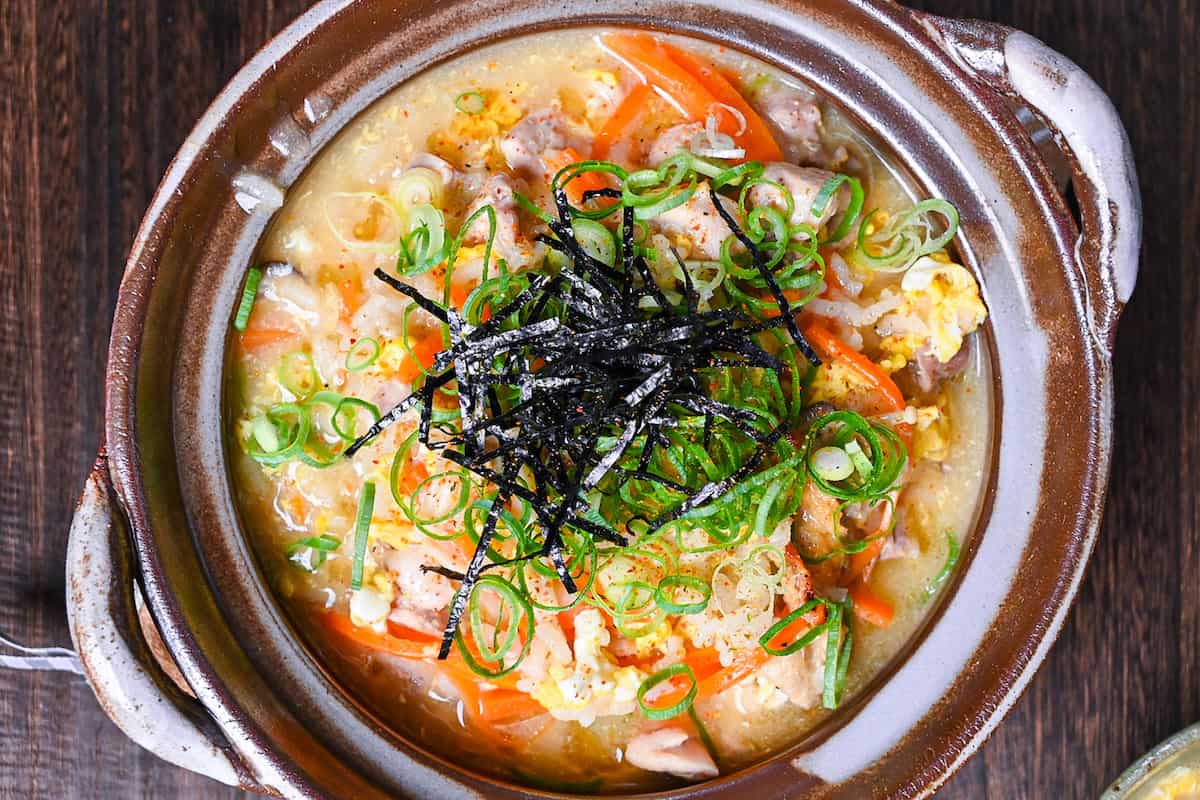

How I Developed This Recipe
While zosui is often seen as a simple dish, it can actually be an unforgettable meal. When I was developing this zosui recipe, my goal was to create a dish that you’d want to make again and again.
The secret ingredient was the flavor booster I created with chicken skin, which adds a rich and savory depth that perfectly complements the mildness of zosui. This addition really made the dish something special.
I hope you’ll try this recipe and see how even a dish as simple as zosui can be really satisfying and delicious!
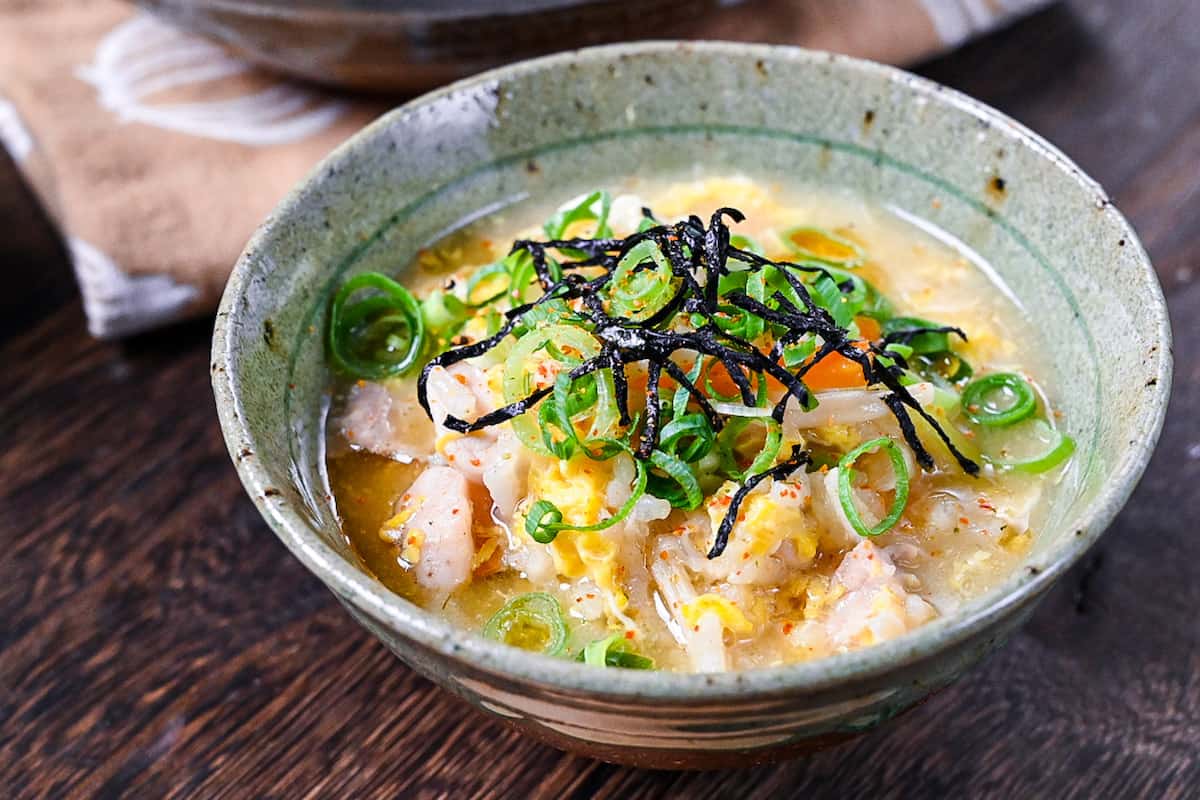
Ingredients & Substitution Ideas
- Boneless Chicken Thigh: Skin-on is preferred. Alternatively, skin-on chicken breast can also be used.
- Dashi Broth: The base of the dish’s flavor. Opt for simple awase dashi, vegan dashi, or instant dashi granules or packets for convenience.
- Sake: Unsalted drinking sake is ideal for its clean taste. Cooking sake can be substituted, with an adjustment to the salt content. For further information on sake types and alternatives, a ‘Sake 101‘ article is recommended.
- Cooked Japanese Short-Grain Rice: Essential for Zosui. The How to Cook Japanese Rice Recipe details information on recommended Japanese rice varieties in the U.S. and cooking methods.
- Naganegi (Japanese Leeks): Use the white part, substituting it with regular leeks if necessary.
- Other Vegetables: Include carrot, shiitake mushroom, enoki mushroom, and ginger. Substitute with similar local vegetables if some are unavailable.
- Light Soy Sauce: For information on the differences between light and dark soy sauce, and brand recommendations, consult my soy sauce guide.
- Eggs: Medium-sized eggs are used in this recipe, but small or large eggs can be used as needed.
- Garnish: Finely chopped green onions, shredded sushi nori seaweed “kizami nori,” Japanese chili powder (shichimi togarashi), and sesame oil add finishing touches to the dish.
Because I’m currently living in Japan, I often use specific ingredients that are hard to get anywhere else. I lived abroad for a long time, so I know how frustrating it is not to be able to find the exact ingredients.
So here, I will list all the substitutions for specific ingredients as much as possible.
- Chicken breast: if you want to use chicken breast instead of thigh, you can use skin-on chicken breast
- Salmon: if you prefer fish instead of chicken, you can use skin-on salmon fillet!
- Mushroom of your choice: even though I used shiitake and enoki mushrooms for this recipe, you can literally use any mushroom you like.
- Dark soy sauce: I specifically used light soy sauce for this, but if you don’t have it in your pantry, you can use dark soy sauce. However, because light soy sauce has more salt in it, use a tiny bit more when you use dark soy sauce.
- If you don’t want to use sake: I know some people might not want to use alcohol in your cooking, in that case, you can omit sake.
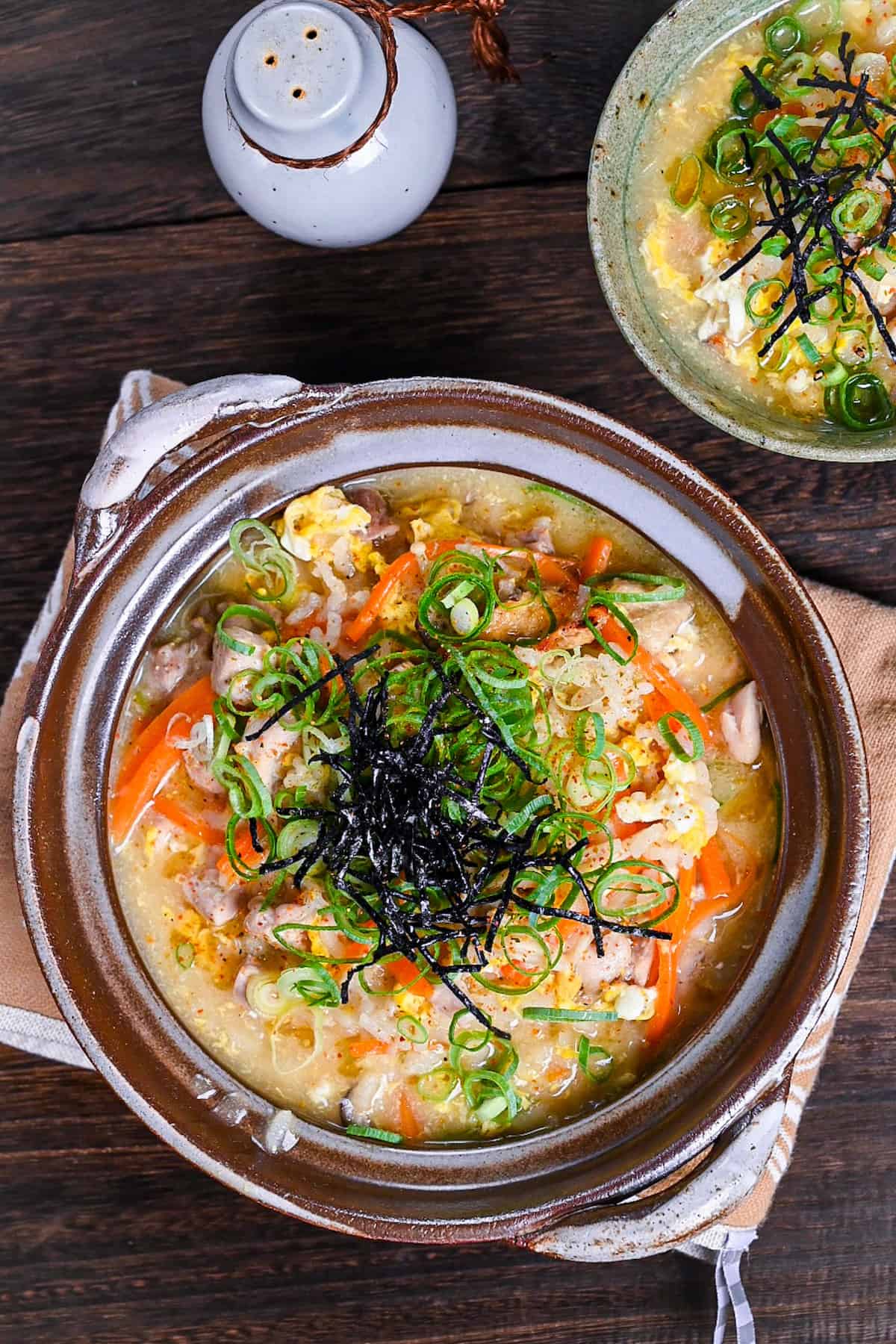
Visual Walkthrough & Tips
Here are my step-by-step instructions for how to make Perfect Zosui at home. For ingredient quantities and simplified instructions, scroll down for the Printable Recipe Card below.
If you prefer to watch the process in action, check out my YouTube video of this recipe for a complete visual walkthrough!
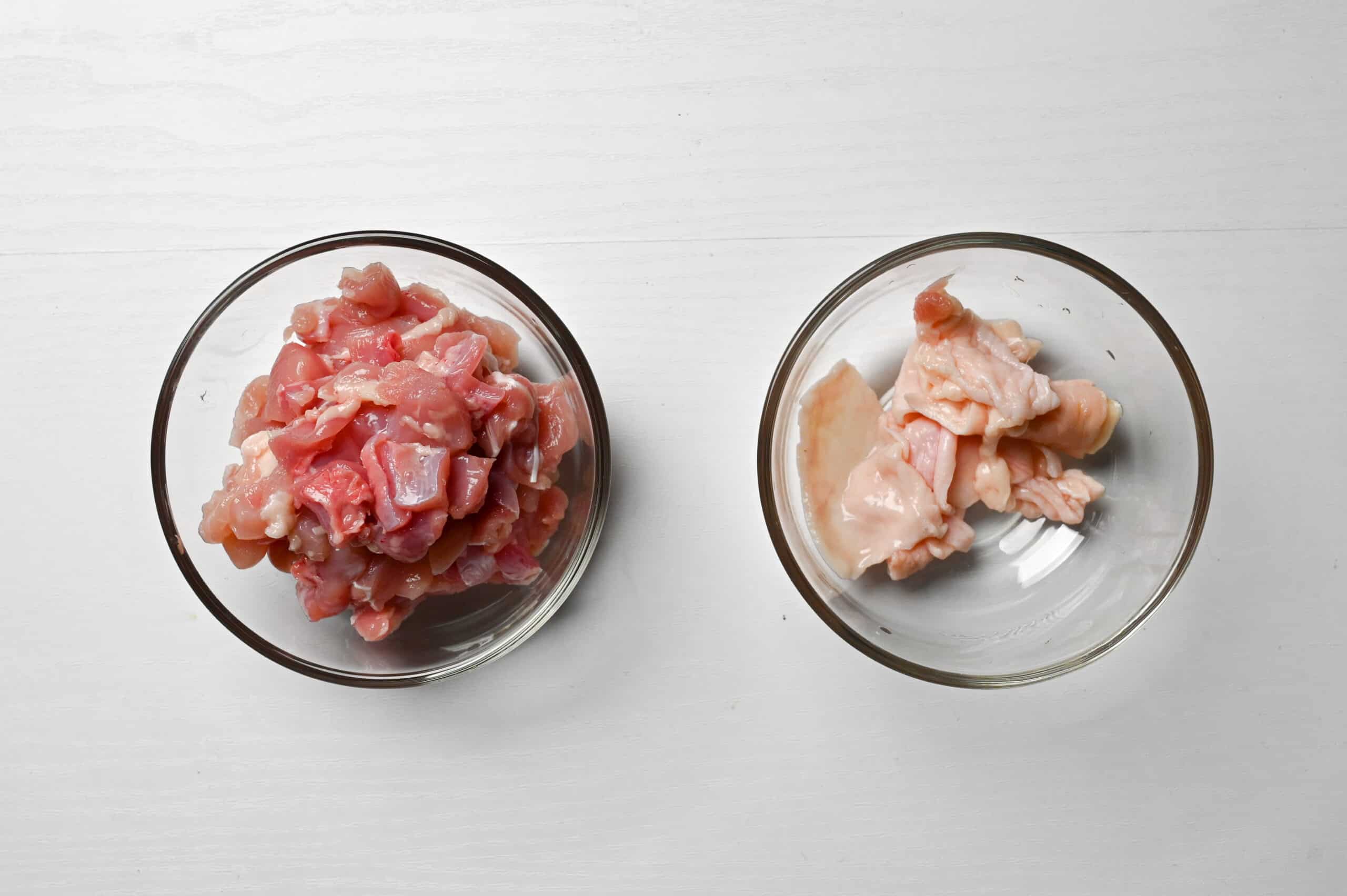
Pull the skin off of the meat and then cut everything into small pieces. The skin will be cooked first until crispy to add more flavor and texture to the dish. (Alternatively, leave the skin whole and crush after frying.)
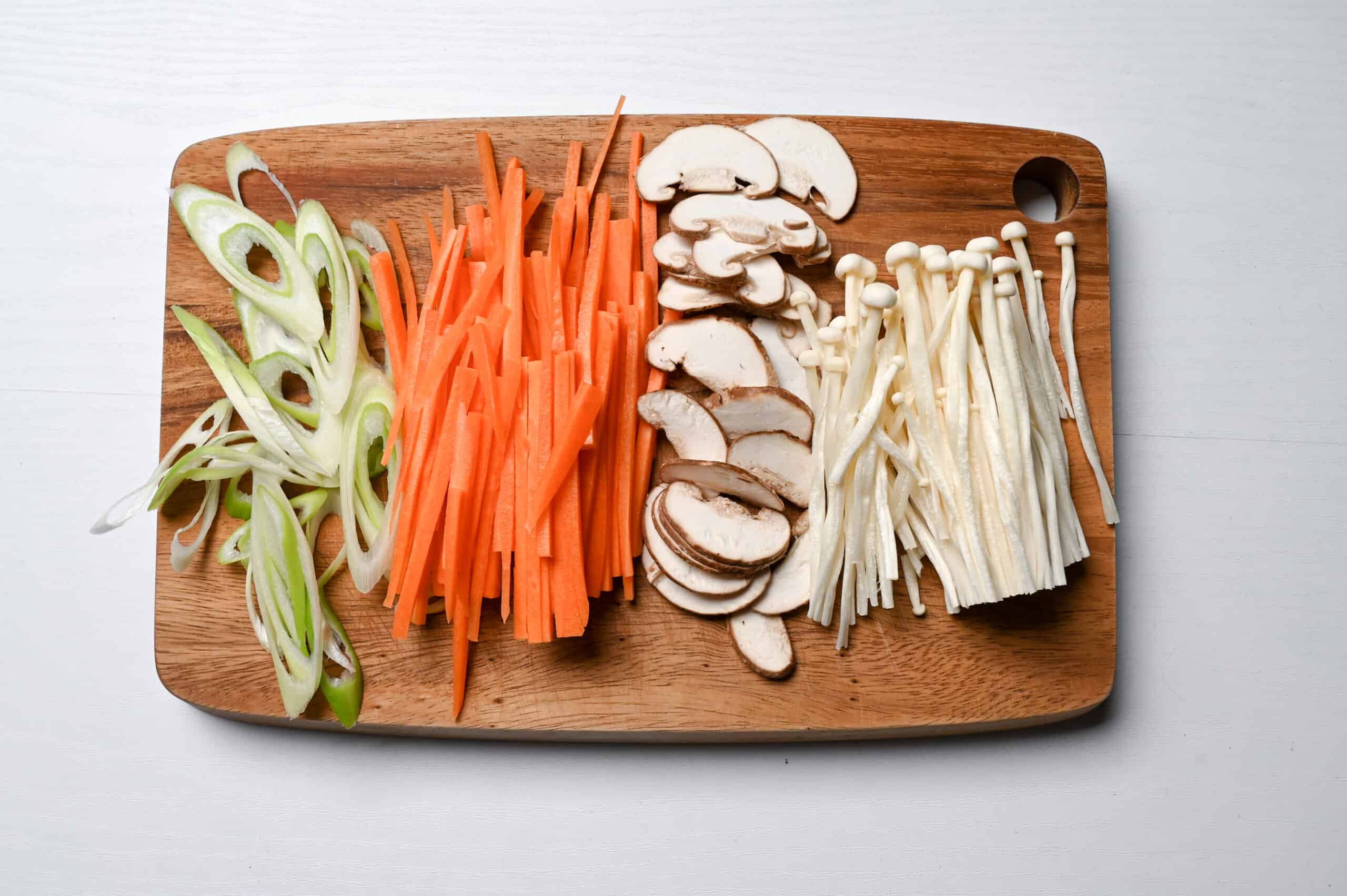
By cutting the vegetables finely, they will cook quicker and reduce the overall cooking time.
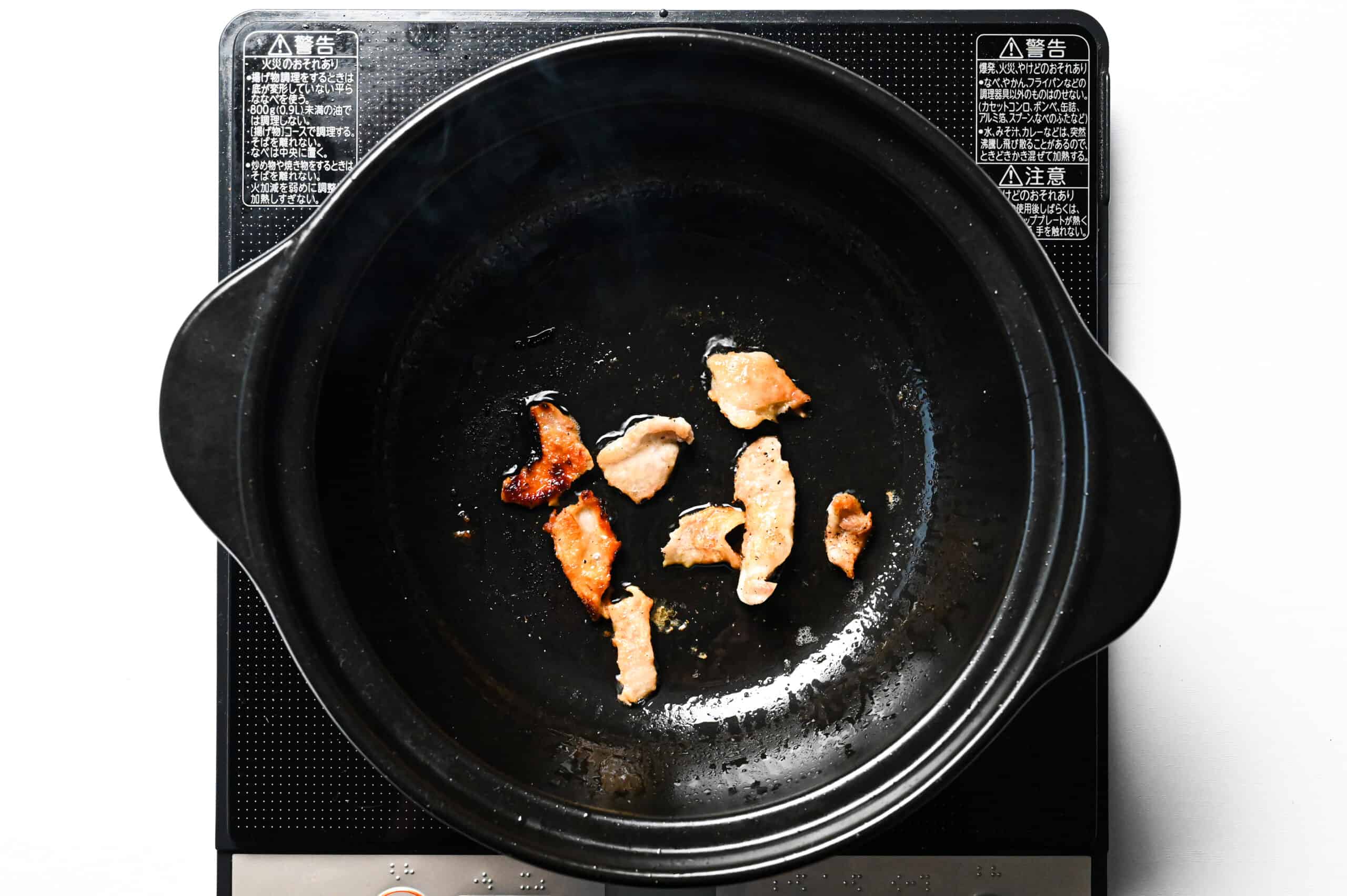
In a pot, heat oil on medium-low and fry the chicken skin with black pepper until crispy. Once crispy, take them out for garnishing at the end.
I have recently become obsessed with using chicken skin to add depth of flavor to my dishes.
To achieve this, I separate the chicken thigh meat from the skin beforehand and cook the skin on low heat until it gets crispy and releases the amazing chicken fat. I then use this in my soup. This is why I specifically use chicken thighs with skin on in this recipe.
Depth of flavor is always important in any kind of chicken soup, and the crispy chicken skin in zosui also adds a bit of a different texture to the dish.
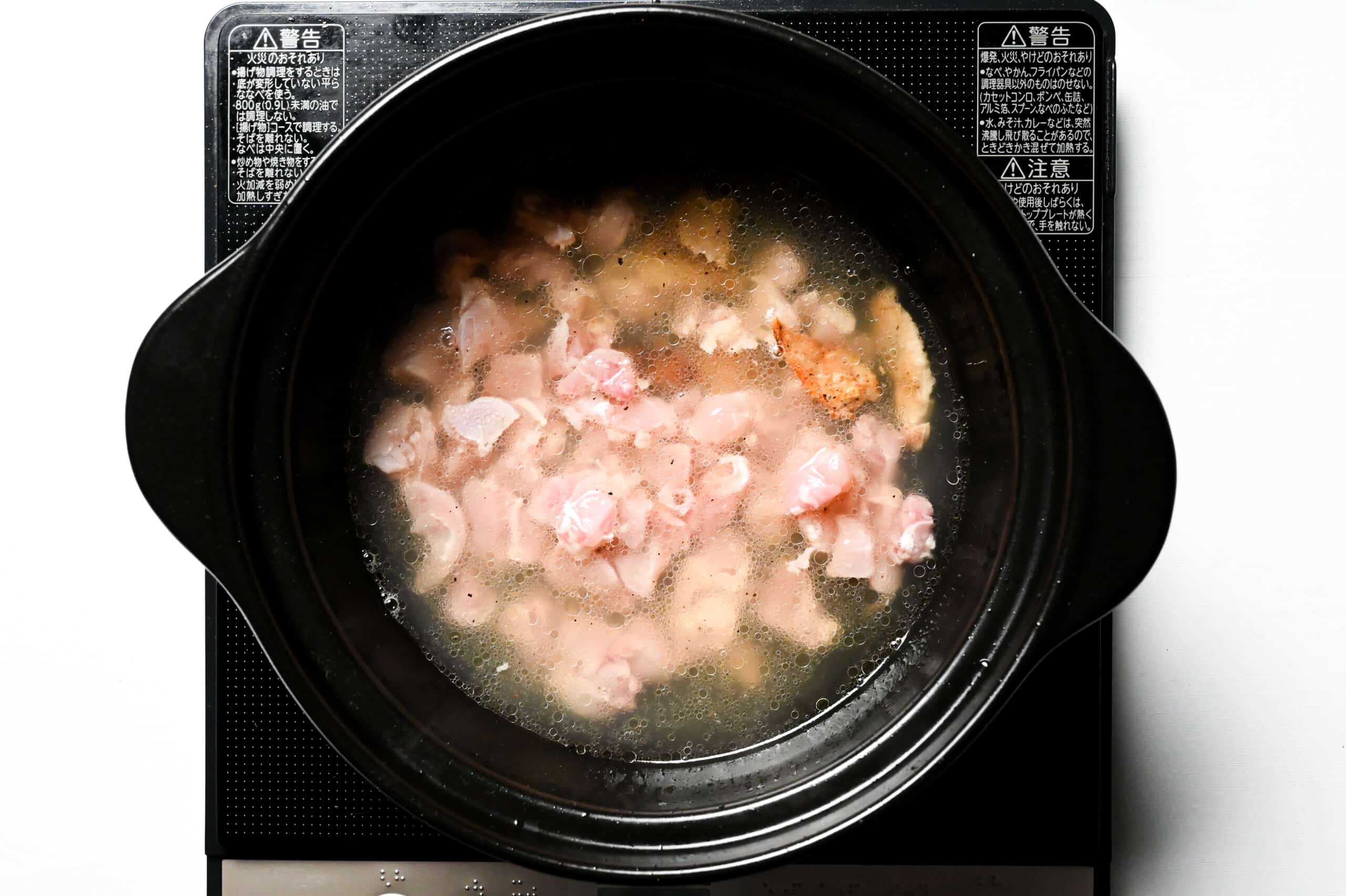
Then, add skinless chicken thigh pieces, dashi stock, and sake. Bring to a boil, then reduce heat.
Yes, that’s right. We wash already-cooked rice under cold running water when you make zosui! And yes, I found it surprising, too, but there is a reason behind it.
If you prefer a sticky texture, you can use it as it is, but if you want it smooth (I personally do), you can rinse it quickly with water to wash off the sliminess on the surface.
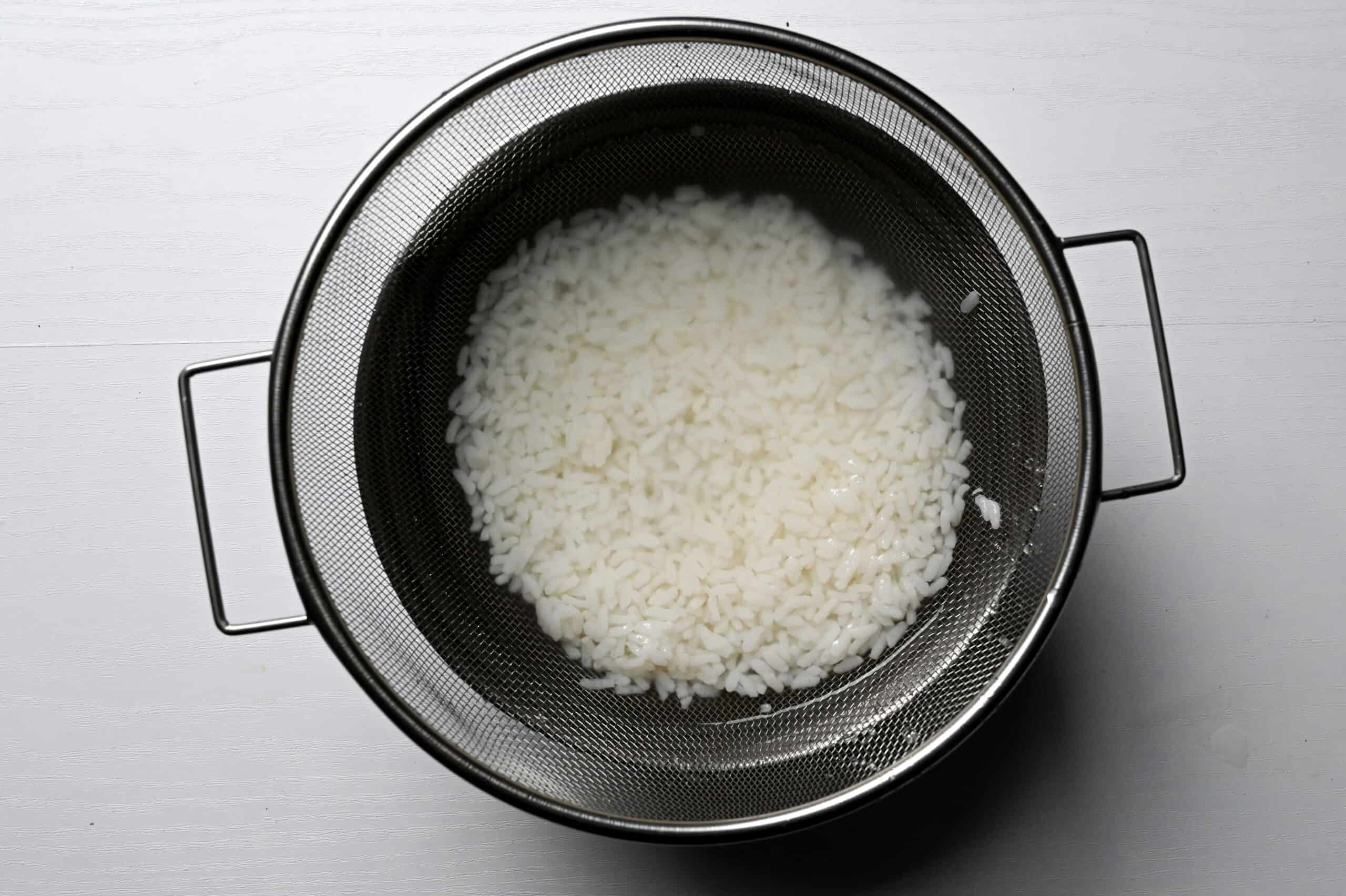
The stickiness increases as it cools down, so cooked rice clumps together when left to stand. If this sticky rice is used to make zosui as it is, the excess starch on the sticky rice will dissolve into the soup, making the soup a bit slimy.
After a quick wash, drain the rice into a colander or other container.
Put the cooked rice in a bowl with water and swish it gently with your hands so as not to crush the rice, then drain the water using a colander or sieve. This process rinses off the starch and prevents the entire dish from becoming too sticky and thick.

When the chicken changes color, add the rinsed rice, carrots, Japanese leeks, shiitake and enoki mushrooms, ginger, and light soy sauce. Mix well and when the carrots have softened slightly, set a timer for 5 minutes.
While you wait for the vegetables to cook, whisk the eggs in a small bowl.
Once 5 minutes have passed, pour the whisked eggs into the pot, and cook for 30 seconds before turning off the heat.
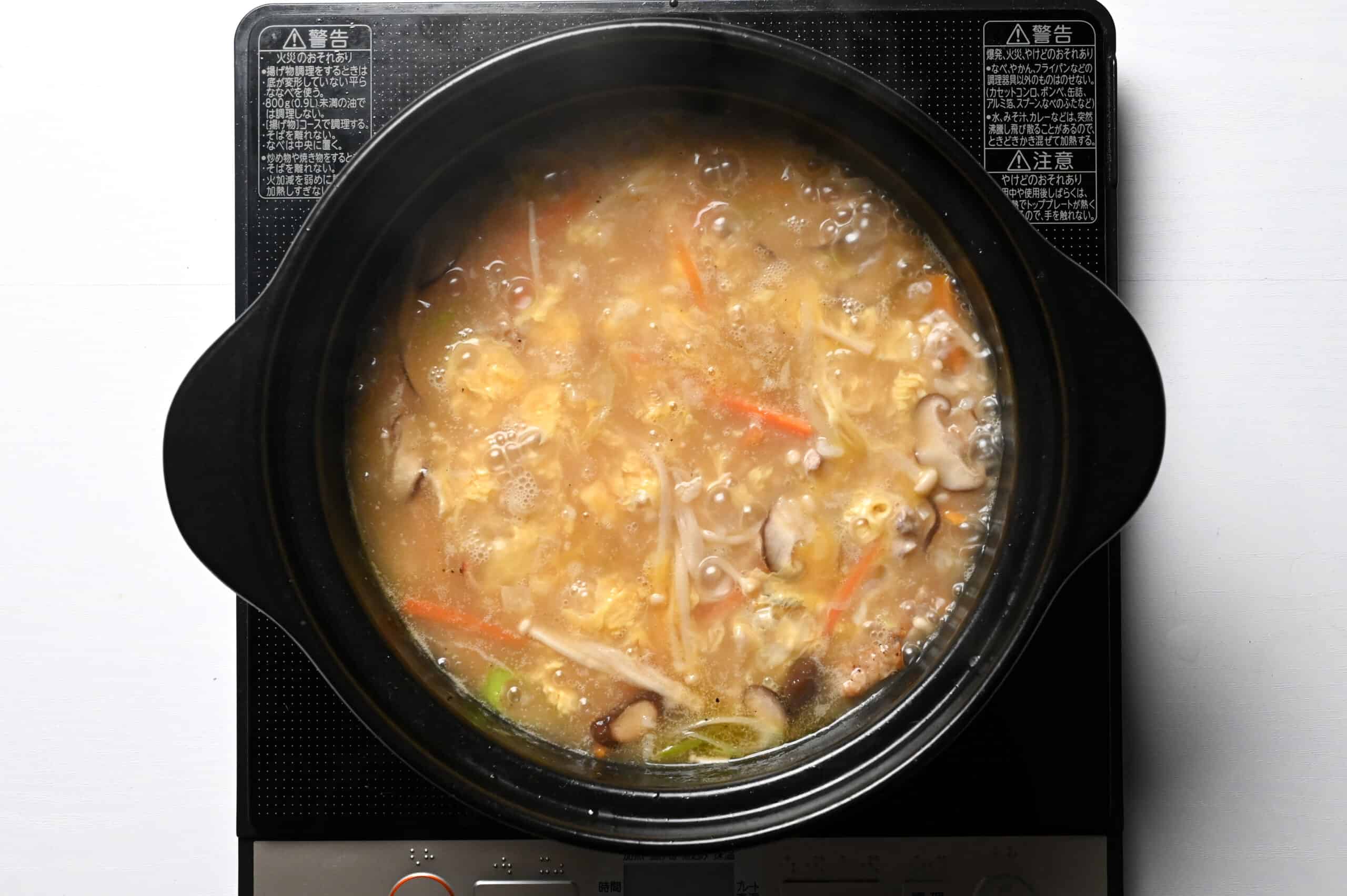
To achieve the silky texture of the eggs, turn off the heat for about 30 seconds after adding them to the soup. The eggs will cook in the residual heat and this will result in a zosui with wonderful textures throughout.
If the eggs are cooked for a long time over a strong heat, they might become tough and rubbery.
Don’t cook the egg too long to avoid a tough and rubbery texture.
Dish up the chicken and rice, garnishing with crispy chicken skin, chopped green onions, shredded sushi nori, Japanese chili powder, and a dash of sesame oil.
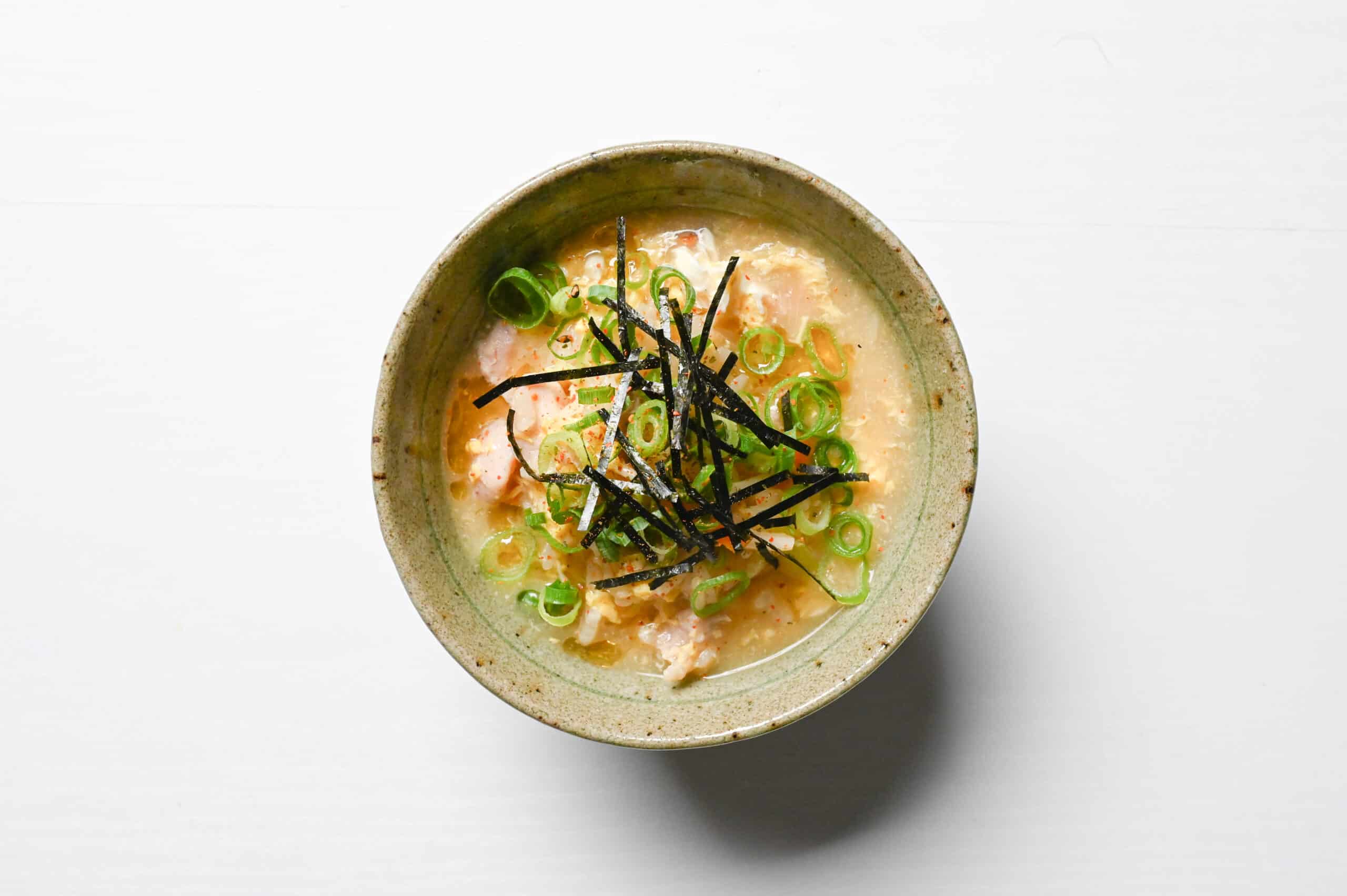
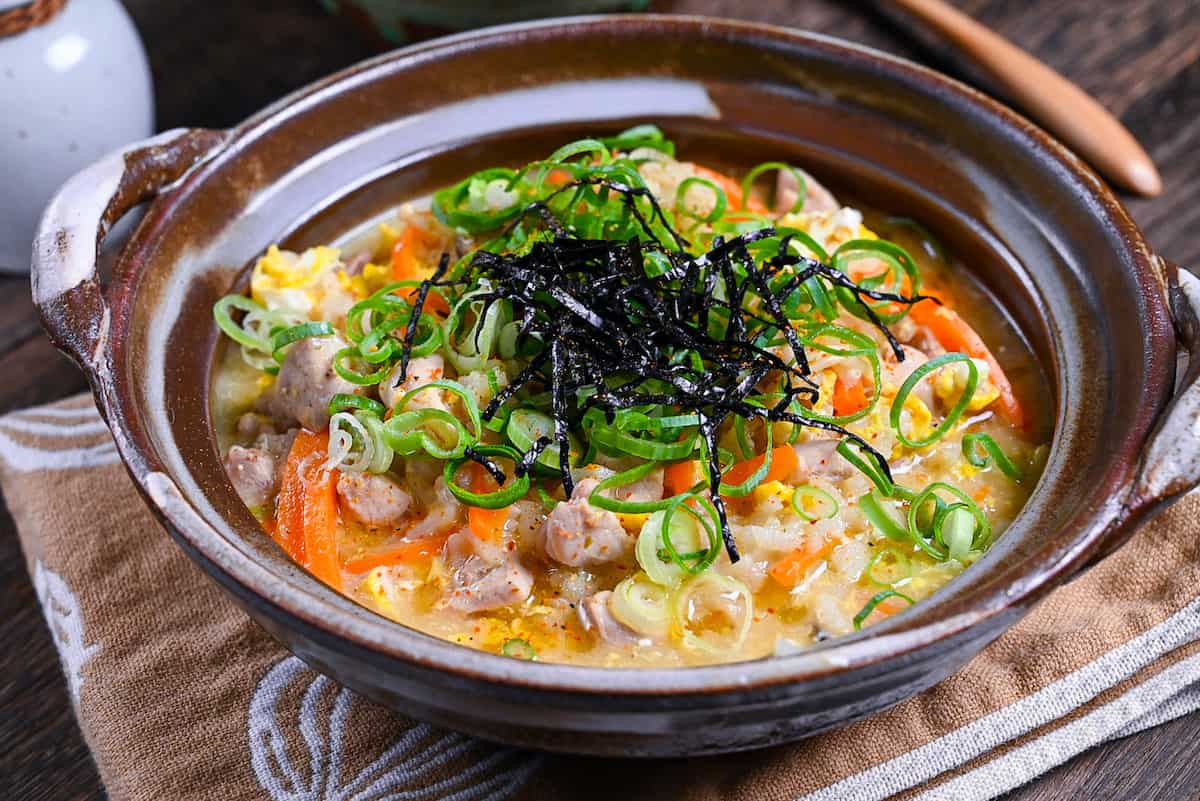
FAQ
Zosui (雑炊) was once written in the old days as 増水 (increased water), indicating the addition of water to rice to increase its volume. Since various ingredients, such as vegetables and seafood, were added to the dish, the term 雑炊 (each character means assorted and freshly cooked) came to be used as an appellation for the soup.
However, the name origin of ojiya (another common name for the dish) is more interesting. Even though there are a few theories on the origin of the word ojiya, it is said to derive from the Spanish word “olla” (oja), which means a pot dish or stewed dish.
It is believed that olla looks similar to ojiya, and the “jiya-jiya” comes from the onomatopoeia for the sound it makes when simmering. This may have led to the name “ojiya” we know today.
While they’re generally considered to be the same thing, some regions in Japan might disagree.
To some people, zosui is a dish where the cooked rice is washed to remove the stickiness /sliminess, which means that the stickier version (where the cooked rice isn’t washed) is called ojiya. On the other hand, some people might say that rice seasoned with miso or soy sauce is called ojiya, whereas rice seasoned with salt or dashi is called zosui.
What I want to say here is there is no concrete definition for each term. These distinctions vary from region to region and household to household, and there are no clear rules, so basically, “zosui” and “ojiya” are the same thing.
Unlike zosui vs ojiya, there is a clear difference between zosui and okayu, meaning they are not the same dish. Okayu (お粥) is basically a dish made by cooking raw rice in large amounts of water until the consistency is extremely soft. No precooked rice is used in okayu.
It is often seasoned simply with salt only (or sometimes with eggs), and because it is easily digestible, it is considered an easy-to-eat dish for children and the elderly, as well as comfort food to eat when you’re sick.
On the other hand, zosui uses already-cooked rice and other ingredients such as vegetables, chicken, or seafood. Zosui is a great dish for using up leftovers.
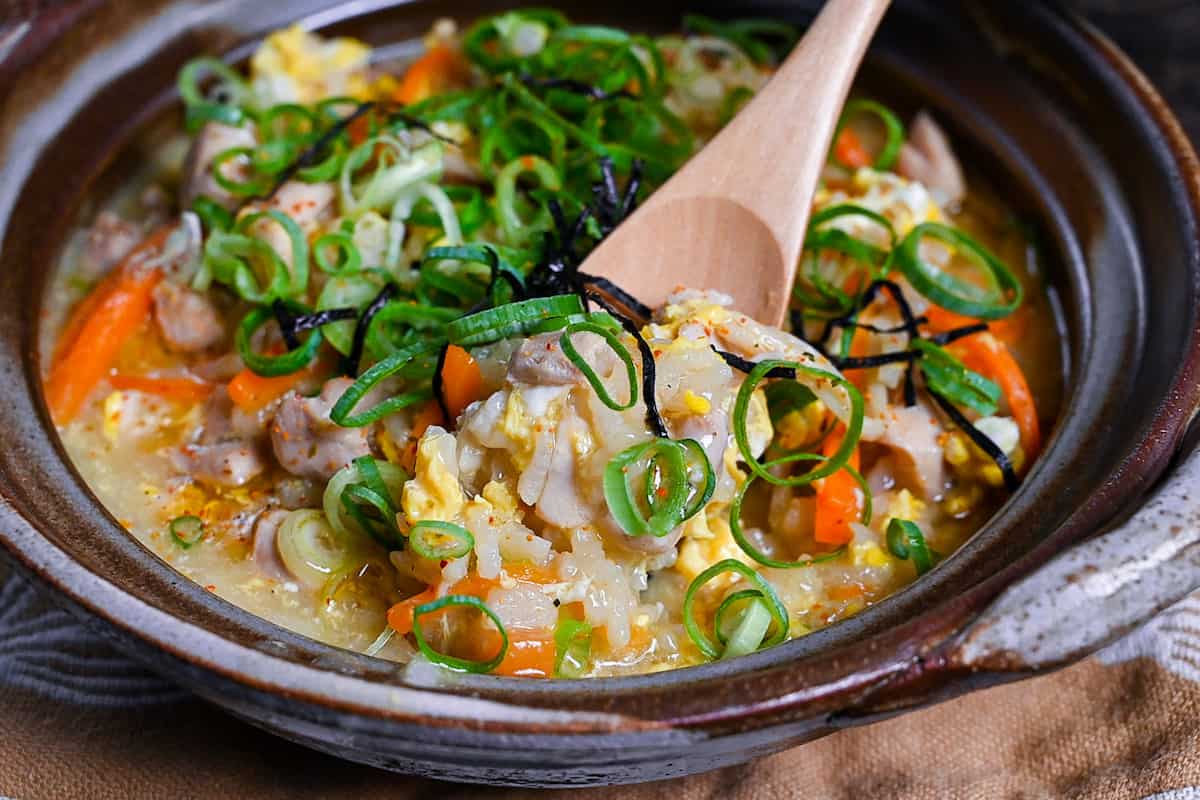
I hope you enjoy this Chicken Zosui recipe! If you try it out, I’d really appreciate it if you could spare a moment to let me know what you thought by giving a review and star rating in the comments below. It’s also helpful to share any adjustments you made to the recipe with our other readers. Thank you!
More Japanese Soup Recipes
- Chicken Miso Soup (Torijiru)
- Japanese Clear Soup (Osuimono)
- Ozoni (New Year’s Soup with Mochi)
- Corn Potage (Japanese Corn Soup)
- Kenchin Jiru (Traditional Japanese Vegetable Soup)
Want more inspiration? Explore my Japanese Soup Roundup Post for a carefully selected collection of tasty recipe ideas to spark your next meal!
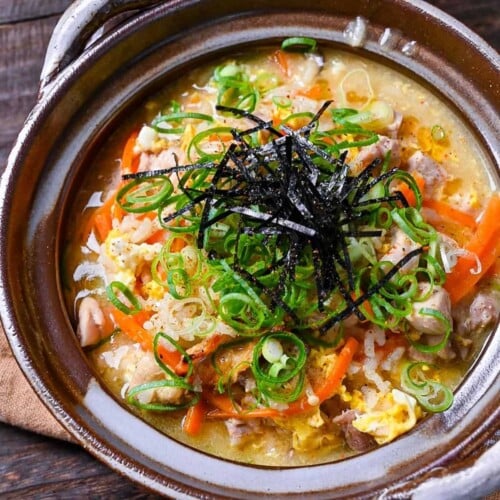
Chicken Zosui (Japanese Rice Soup)
Ingredients
- 150 g boneless chicken thigh skin-on
- 1 tsp cooking oil
- 1 pinch ground black pepper
- 400 ml dashi stock
- 1 tbsp sake
- 200 g cooked Japanese short-grain rice see my recipe, how to cook Japanese style rice
- 30 g Japanese leek (naganegi) white part diagonally sliced
- ½ carrot julienned
- 2 fresh shiitake mushroom thinly sliced
- 100 g enoki mushrooms roots removed
- 15 g ginger root grated
- 3 tbsp Japanese light soy sauce (usukuchi shoyu) see note for how to use dark soy sauce
- 2 egg
- finely chopped green onions optional garnish
- kizami nori (shredded nori) optional garnish
- Japanese chili powder (shichimi togarashi) optional garnish
- toasted sesame oil optional garnish
My recommended brands of ingredients and seasonings can be found in my Japanese pantry guide.
Can’t find certain Japanese ingredients? See my substitution guide here.
Instructions
- Peel the skin off of 150 g boneless chicken thigh, cut the meat into small pieces and the skin into bitesize pieces.

- Heat up a large pot on medium-low and add 1 tsp cooking oil. Once heated, add the chicken skin with 1 pinch ground black pepper and fry until crispy on both sides.

- Once the skin is crispy, remove it and place it on a piece of kitchen paper. Set aside for later.

- Add 400 ml dashi stock and 1 tbsp sake to the pot and bring to a boil over medium-high heat. Once boiling, lower the heat to medium-low and add the chicken thigh.

- While the chicken cooks, place 200 g cooked Japanese short-grain rice in a bowl and fill it with fresh cold water. Swish it around with your hand to gently remove the excess starch and then pour it through a sieve or colander to drain the water.

- When the outside of the chicken is no longer pink, add the rice, ½ carrot, 30 g Japanese leek (naganegi), 2 fresh shiitake mushroom, 100 g enoki mushrooms, 15 g ginger root and 3 tbsp Japanese light soy sauce (usukuchi shoyu).

- Once the carrots are slightly softened, set a timer for 5 minutes. During this time, crack 2 egg into a small bowl and whisk.

- After 5 minutes, pour the whisked egg around the pot and set a timer for 30 seconds. When 30 seconds are up, turn off the heat and dish up.

- Garnish with the chicken skin from earlier, finely chopped green onions (green part), kizami nori (shredded nori) and Japanese chili powder (shichimi togarashi) (according to your tastes) and a dash of toasted sesame oil.

- Enjoy!
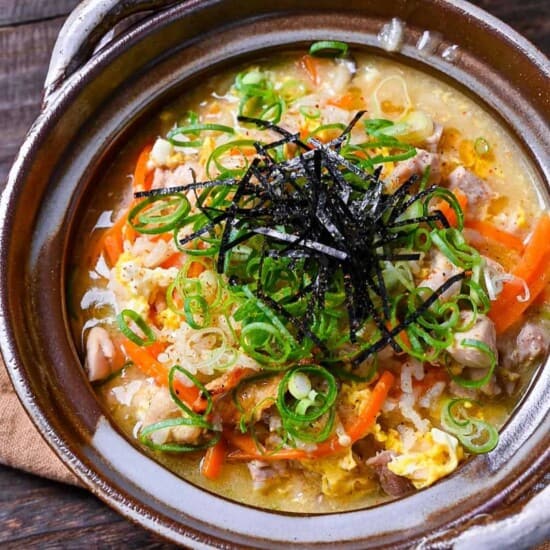






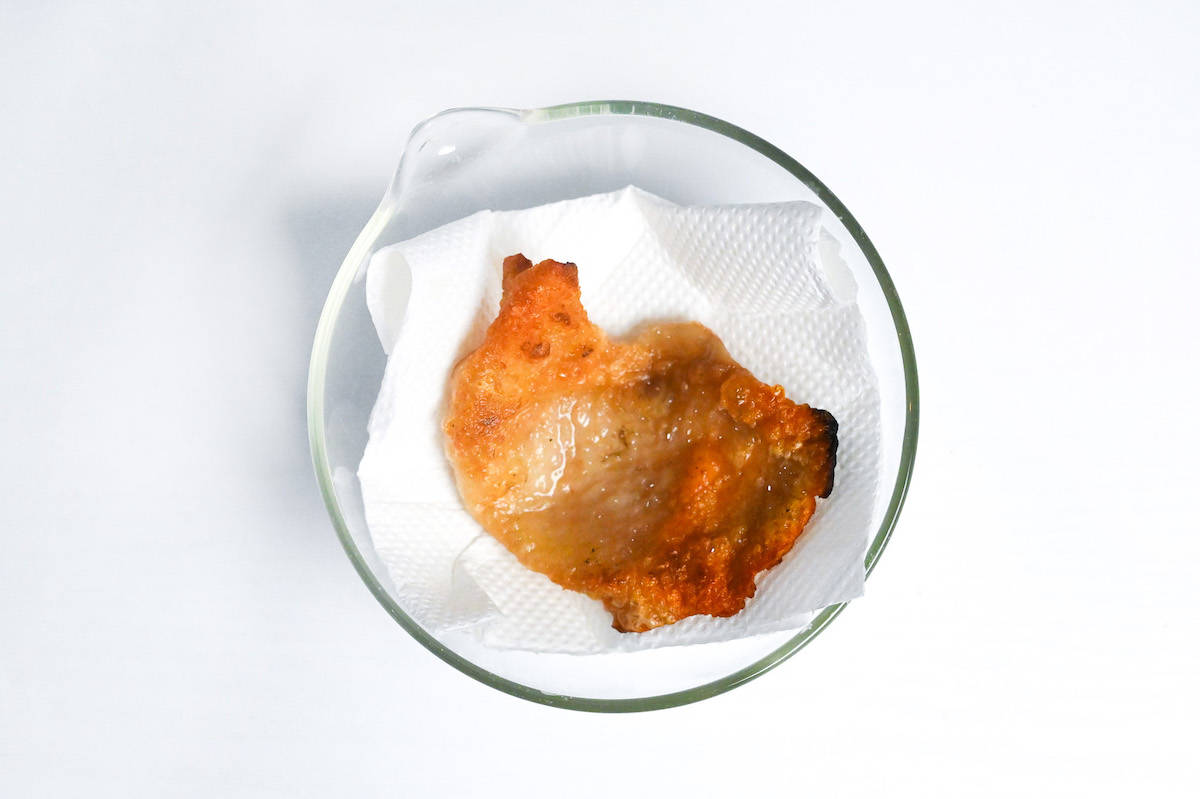






Our son and wife are having a baby in Japan…his wife is Japanese. We are hosting a Japanese themed baby shower in January. I want to make an authentic chicken and rice soup that I can freeze ahead of time and just heat up the day of the party. Can I freeze the chicken and rice soup and just add the egg and green onions after it is reheated? Thanks!
Hi Diane, congratulations on the new addition to your family!
Japanese rice is very absorbent and tends to soak up the soup in storage, so I would recommend making the soup and rice separately, and freezing them separately. When it comes to reheating, you can heat up the soup first and add the frozen rice directly without thawing. Once it’s heated all the way through, add the egg and green onions. Hope this helps!
Hallo,
Die beste Reissuppe die ich kenne.
Vielen Dank wie immer für das Rezept.
Ich liebe sie.
Sie ist äußert appetitlich.
Unbedingt nachkochen 🙂 vorallem jetzt wo es wieder kälter wird.
Liebe Grüße von Kathleen.
Hallo Kathleen,
vielen Dank für deinen netten Kommentar und dein Foto!
Ich sehe deine Fotos immer gerne!
P.S. I hope my sentences in German are okay!
Yuto
Sehr gerne.
Ich möchte es so gerne teilen was ich nach koche 😀
Weil ich die Japanische Küche sehr schätze und diese Rezepte hier der wahnsinn sind. Super. Ich freue mich sehr darüber.
Your sentences in German are ok. Yes in any case.
(My english is not so good.. 😀 hehe..)
Good Day. Yuto
Amazing recipe. So flavorful and perfect for winter.
Love it
Hi Ralph,
Thank you for trying out my recipe and sharing your wonderful photo! I’m so happy to hear you enjoyed it! 🙂
Yuto
This is fabulous!
Thank you so much, Trish!